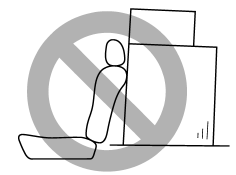Loading your vehicle
WARNING
Never allow passengers to ride on a folded rear seatback, in the trunk or in the cargo area. Doing so may result in serious injury.

WARNING
● Never stack luggage or other cargo higher than the top of the seatback because it could tumble forward and injure passengers in the event of a sudden stop or accident. Keep luggage or cargo low, as close to the floor as possible.
● When you carry something inside the vehicle, secure it whenever you can to prevent it from being thrown around inside the vehicle during sudden stops, sharp turns or in an accident.
● Do not pile heavy loads on the roof. These loads raise the vehicle’s center of gravity and make it more prone to tip over.
● Secure long items properly to prevent them from shooting forward and causing serious injury during a sudden stop.
● Never exceed the maximum load limit. If you do, some parts on your vehicle can break, or it can change the way your vehicle handles. This could result in loss of control and cause personal injury. Also, overloading can shorten the life of your vehicle.
● Do not place anything on the rear shelf behind the rear seatback (Legacy) or the extended luggage cover (Outback). Such items could tumble forward in the event of a sudden stop or a collision. This could cause serious injury.
CAUTION
Do not carry spray cans, containers with flammable or corrosive liquids or any other dangerous items inside the vehicle.
NOTE
For better fuel economy, do not carry unneeded cargo.
See also:
Snow tires
- When replacing original tires with
winter (snow) tires, make sure
you use only the same size,
construction and load range as
the original tires listed on the tire
placard. Using other ...
Cup holders
Take care to avoid spills. Beverages,
if hot, might burn you or your
passengers. Spilled beverages may
also damage upholstery, carpets or
audio equipment. ...
Summer tires
Summer tires are high-speed capability tires best suited for highway driving under dry conditions.
Summer tires are inadequate for driving on slippery roads such as on snowcovered or icy roads.
If y ...


